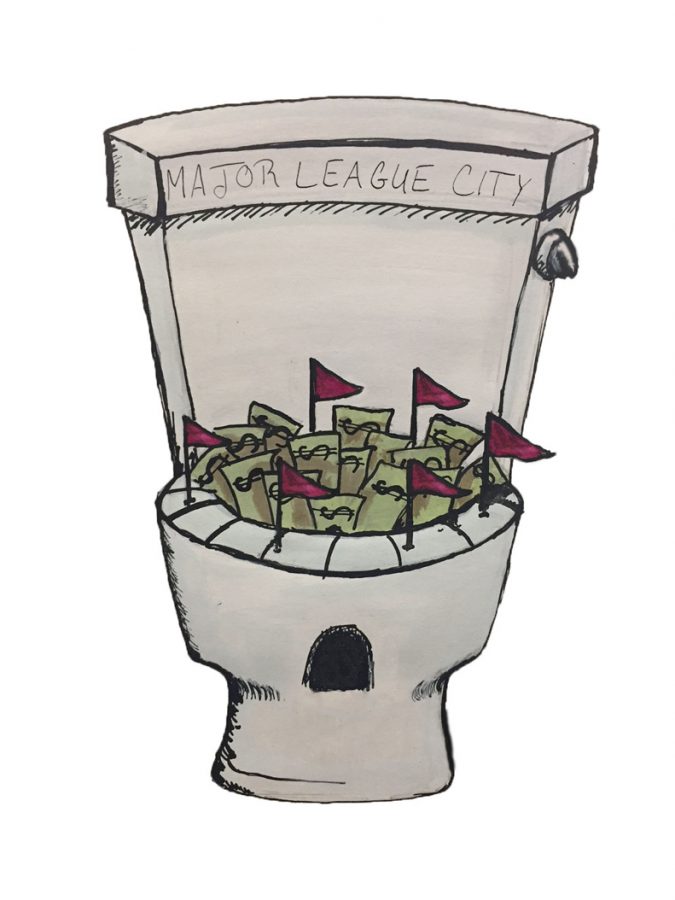America is addicted to building sport stadiums.
Almost every stadium America builds receives public funding, but these newly constructed stadiums often don’t make cities the money they are expected to. Cities build stadiums mainly in response to fan demands but often overlook the economic repercussions of these choices.
Sports often make up a large part of a city’s character and culture and people view them with a sense of pride, which explains why sports games are some of the most attended events in American cities today. Major league baseball averages 30,163 fans per game, the NFL 69,487 per game and the NHL 17,548 per game.
For loyal fans, all that matters is having the team stay where it is, and owners know they can use the threat of relocation to encourage cities to help fund the new stadium. Consequently, civic pride and the threat of relocation are the two main reasons that inspire cities to shell out taxpayer dollars for new stadiums.
These stadiums are guaranteed to cost hundreds of millions of dollars to build and open. Minneapolis spent around $500 million dollars on a new football stadium in 2013, Detroit will spend $250 million to build a new arena for the Red Wings and Pistons that will open in late 2017 and Atlanta will spend $300 million dollars to build its new Falcons football stadium that will open later this year.
In Pittsburgh, the city spent $461 million building PNC Park and Heinz Field in 2001, yet they still owed $40 million on the Three Rivers Stadium built in 1970.
The amount of money cities spend on these stadiums is jaw-dropping, especially when these funds could be invested into other urban projects, such as schools, hospitals or community building. For those who may not be sports fans, some would argue, the extra tax dollars that go toward building grand sports colosseums could be better spent helping the city community.
On the other hand, sporting events do bring in more money as fans flock to the city and to its bars, restaurants and shops. But when you factor in the extra funds spent on police, transportation and cleanup, the cities oftentimes just break even.
Yet, local governments spend so much money on stadiums as a way to make themselves more attractive to the leagues and team owners.
They should instead encourage the owners and the league to privately fund new stadiums. In the NFL, for example, owners and leagues are not strapped for cash and should have the ability to build these facilities on their own. The NFL itself made $7.24 billion in revenue in 2015 and of the owners in the NFL, only Dan Rooney of the Steelers, Carlo and Mark Davis of the Raiders and Mike Brown of the Bengals are worth less than $1 billion.
Rams owner Stan Kroenke ranks at number two on the list with a net worth of $5.3 billion. He is setting an example for NFL stadiums across the league by deciding to privately fund his new Los Angeles facility, a change that will make sure the city is not footing the bill. This is a path that could and should be the new way of financing professional sports arenas.
The most recent development in the NFL also highlights the league’s need to turn to private means for financing new facilities. Before the Chargers officially announced their move from San Diego to Los Angeles in January 2017, their fans made a music video about why they should stay. San Diego had a chance to keep their team but the residents voted against the tax increase that the city would need to build the stadium and keep the Chargers in their hometown. While some still feel passionate about sports teams, the cost to city dwellers is causing publicly funded stadiums to fall out of favor with the public.
With San Diego’s decision not to publicly fund a new stadium and the Rams owner Stan Kroenke deciding to privately fund his new Los Angeles stadium, it looks as though cities are starting to realize that stadiums might not always be worth it — and Kroenke is showing that public funds are not always necessary to build a new stadium for these projects.
For many cities, sports are an integral part of the city’s culture. But priorities that place new stadiums over taxpayers’ more pressing needs should be resigned to the past — and the era of privately funded stadiums should be the future.


